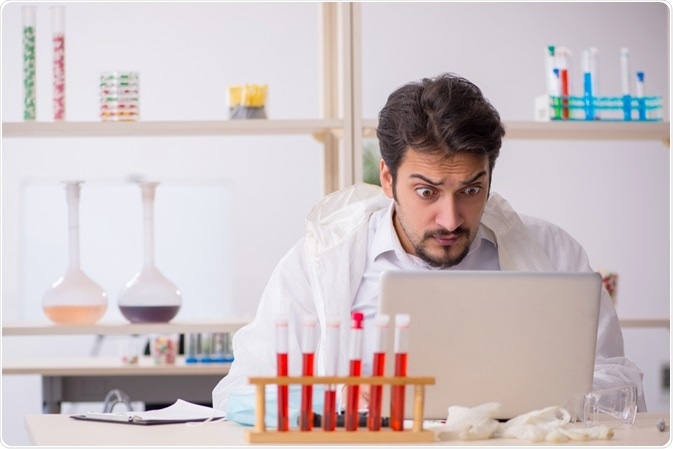In science, the definition of "error" is not always the same as in normal language. An error in chemistry may still be a mistake, for example reading a scale incorrectly, but could also include normal unavoidable inaccuracies associated with measurements in an experiment in a lab.

Image Credit: Elnur/Shutterstock.com
Using this definition of error, there are many possible different sources of error in an experiment or scientific process. In fact, the result of a chemical experiment may never give a definitive answer due to the number of possible errors and the result is usually a statistical approximation of the absolute answer.
Another area where chemistry and general conversation differ is the use of accuracy and precision. In Normal conversation these two words are interchangeable but in analytical chemistry, they have different meanings:-
- Accuracy is a measure of how close a measurement/measurements is to the true or accepted answer.
- Precision is how closely multiple measurements agree with each other, it is actually a measure of consistency. In practice, precision is related to the standard deviation of the repeated measurements.
What is an error
“Error” in Chemistry is defined as the difference between the true result (or accepted true result) and the measured result. If the error in the analysis is large, serious consequences may result. As reliability, reproducibility, and accuracy are the basis of analytical chemistry.
Errors fall into two basic categories:-
- Indeterminate (or random) errors are caused by uncontrollable or unknown fluctuations in variables that may affect experimental results. Indeterminate or accidental errors can arise from uncertainties in measurements.
- Determinate errors are those errors that are known and controllable errors e.g instrument errors, personal errors, etc. Determinate or systemic errors are known and avoidable. They can be composed of two parts that have a constant value or a proportionate value.
Accurate measurements have low Determinate Error. Precise measurements have low Indeterminate Error.
Types of error
- Human Error: Inaccuracies or mistakes by a person undertaking an experiment could be the cause of some errors. The types of human error are limitless and could include things like incorrect reading of gauges, miscalculating when diluting ingredients or similar calculations, and spillage when handling chemicals during transfer or following the wrong instructions for the experiment. Depending on what type of mistake is made and where in the process it happens will have a significant impact on the magnitude of its influence on the final solution. Human error can be minimized or eliminated by careful attention to procedures and techniques.
- Calibration Error: Inaccurate calibration of instruments can lead to errors in chemical experiments. Calibration is the process of adjusting or checking an instrument according to the manufacturer's instructions to ensure that the instrument gives accurate and reproducible readings. Ideally, instruments should be calibrated regularly or even every time they are used so that they do not produce errors. Some instruments or equipment will be more prone to error than others and the chemist should assess each instrument's requirement.
- Estimated Measurement Error: Estimating a measurement could lead to the production of an error. Some estimations are hard to eliminate. When filling a beaker with water to a specific volume there is potential to be either marginally over the mark or marginally under the mark but the chemist will estimate when they think it is spot on the mark. In an experiment that involves a color change the moment of change will be estimated by different people at different shades of color depending on their eyesight.
- Measurement Device Limitation Error: The limitations of lab equipment in a lab used to measure parameters will be a potential source of error. Every instrument or device, no matter how accurate, will have limitations on accuracy associated with it. For example, a measuring flask may be provided by the manufacturer with a built-in accuracy of plus/minus 1 to 5 percent. Using this measuring flask to make measurements in a lab, therefore, introduces an error of up to 5 percent in any volume measurement.
Interpretation of experimental results requires some mathematical knowledge and the sensitivity of instruments and processes. An understanding of significant figures is often required. For example, if you are measuring the length and your instrument can read to the nearest millimeter and a calculation gives a figure to micrometers the significant figure is millimeters as there is no way of measuring smaller distances accurately.
When interpreting multiple results the values can be reported as the mean or the median. The median is the middle value and the mean is the arithmetic average. An outlier value may cause an error where an outlier is a result that is significantly different from all the other results. This could lead to a gross error being reported. The relative error can be calculated by taking the actual value minus the measured value and dividing it by the actual value and is usually expressed as a percentage.
Multiple experimental results can also be analyzed us Gaussian standardized normal curves where one standard deviation will contain 68% of results and two standard deviations will include 95% of results.
In summary, it is very unlikely that a chemical experiment will give the absolute answer. There will always be some element of error in the result. If the error is determinate it can be minimized or eliminated but indeterminate errors will not necessarily be known. The job of the chemist is to minimize or compensate for the errors to get an answer that is accurate as possible using suitable mathematical and practical strategies.
Further Reading